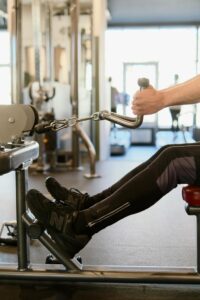Studies indicate that about 38% of Americans make resolutions at the start of each year, and around half (48%) of those resolutions have exercise as the top priority. However, almost a quarter of those who choose exercise as a priority for the new year quit in the first week, and only a third go past the first month.
All this seems to indicate that while many Americans recognize the necessity and benefits of exercise, there is a struggle with follow-through. Ironically for some, however, the reverse can happen, and they become addicted to exercise. This makes it possible that a healthy discipline can become a detrimental one to a person’s well-being. Glendale Christian Counseling offers guidance in finding a balanced approach to physical health, ensuring that exercise remains a positive and life-giving practice.
The good that exercise can do for you
 If we are honest, most of us probably need to get a lot more exercise than we currently do. The issue for most of us is that we are getting far too little exercise, and so the question of getting too much exercise does not even register. However, there is a sense in which even if you are not exercising a whole lot, you may still be exercising more than you should. That probably needs a bit of explanation.
If we are honest, most of us probably need to get a lot more exercise than we currently do. The issue for most of us is that we are getting far too little exercise, and so the question of getting too much exercise does not even register. However, there is a sense in which even if you are not exercising a whole lot, you may still be exercising more than you should. That probably needs a bit of explanation.
Exercise works for us in several ways. It helps us to connect with other people, such as when you go for a walk or a run with a friend. Being outdoors and doing something physical with your body makes a world of difference for your mental and physical health.
When you exercise, your body benefits physically. Good cholesterol (high-density lipoprotein) gets boosted while unhealthy triglyceride levels are lowered. This decreases your risk of cardiovascular diseases by maintaining appropriate blood flow without pressure to arteries and veins.
There is more, though, that exercise does. It also helps in other ways, including the following:
- It boosts your energy and improves your mood.
- It helps you keep your weight under control.
- It helps you to sleep better.
If all this and more is true, then how could exercise ever be bad? Surely, it is a case of the more, the better, isn’t it?
When does it become exercise addiction?
How do you know when it has slipped from healthy to concerning? When is it becoming an addiction? Consider the following when reflecting on your own habits.
Is exercise negatively affecting your relationships?
If your workout goals, such as extreme weight loss or training for an event, begin getting in the way of spending time with family and maintaining your relationships, then you may be doing too much.
 Do you have pain and exhaustion, but cannot seem to take a break?
Do you have pain and exhaustion, but cannot seem to take a break?
When you work out, often it does tire you out and leaves you feeling sore. If you find yourself with soreness lasts more than two days, or if you are injured and keep on exercising, you may be doing too much of it.
Are you using exercise to avoid difficult things in life?
We all have our ways to unwind and unplug from the various stresses of life. However, if you find yourself going out for a run or a walk all the time when problems come up or a difficult conversation starts, then perhaps you are exercising too much. You might be using exercise as an avoidance technique and undermining your well-being.
Are you struggling with new health problems as a result of exercise?
Are new health issues coming up because of exercising extensively? When you exercise as a physician directs, it should not lead to the decline of your health.
If you find yourself having chronic colds, infections, and other illnesses, sleeplessness, amenorrhea (loss of menstruation), weight gain, extreme weight loss, or a general decline in your stamina, then it is likely you are doing too much.
Are you feeling obsessively compelled to exercise?
While exercise usually boosts your mood and gives you energy, if exercise is not something you find pleasant to do but is something that you feel compelled to do, you may be flirting with addiction. If you are doing it but not enjoying it, or you feel guilty when you are not exercising, that might be a sign that there is a problem, and you are doing too much.
Getting healthy after you’ve done too much exercise
If you exercise too much, you can damage your body in the short and the long term. Organs such as your heart or kidneys may be at risk of damage. However, there are ways to get healthy and balanced again after exercising too much.
 You can start by resting for a couple of weeks or more. This will give you time for your body to recover, your energy levels to rise again, and for you to regain your joy and motivation concerning exercise. It is also important that when you reinitiate an exercise routine, you build rest days into your weekly training regimen so that you do not overdo it.
You can start by resting for a couple of weeks or more. This will give you time for your body to recover, your energy levels to rise again, and for you to regain your joy and motivation concerning exercise. It is also important that when you reinitiate an exercise routine, you build rest days into your weekly training regimen so that you do not overdo it.
Importantly, you need to do some self-care. Make sure that you eat a balanced and nutritious diet, and that you sleep well, too. When you are clear to begin exercise again, make sure your nutrition sustains your level and intensity of training, and that you are getting enough rest each night to have energy to get through your workouts. Part of self-care is hydrating, and you need to consume more water when you exercise.
It is essential that you speak to someone, like a counselor, to explore how exercise became an obsession or addiction. If there are issues in your life such as relationship conflict or body perception issues that fuel overexercising, you should talk to a professional counselor. Your counselor can help you develop healthy habits as well as identify and address unhelpful patterns of thought and behavior that can drive overexercise.
Reach out for help for exercise addiction
If you can relate this description of overexercising or exercise addiction, it is important that you get help. Please reach out to us today and we can set up an appointment for you with a trained Christian counselor at Glendale Christian Counseling in our directory. Together you can find the way back to making exercise a healthy tool to positive living.
“19 Surprising New Year’s Resolution Statistics” (2024 Updated), insideoutmastery.com/new-years-resolution-statistics/Photos:
“Working Out”, Courtesy of Ivan Samkov, Unsplash.com, CC0 License; “Treadmill”, Courtesy of Andrea Piacquadio, “Treadmill”, Courtesy of Andrea Piacquadio
-
Kate Motaung: Curator
Kate Motaung is the Senior Writer, Editor, and Content Manager for a multi-state company. She is the author of several books including Letters to Grief, 101 Prayers for Comfort in Difficult Times, and A Place to Land: A Story of Longing and Belonging...
DISCLAIMER: THIS ARTICLE DOES NOT PROVIDE MEDICAL ADVICE
Articles are intended for informational purposes only and do not constitute medical advice; the content is not intended to be a substitute for professional medical advice, diagnosis, or treatment. All opinions expressed by authors and quoted sources are their own and do not necessarily reflect the opinions of the editors, publishers or editorial boards of Stone Oak Christian Counseling. This website does not recommend or endorse any specific tests, physicians, products, procedures, opinions, or other information that may be mentioned on the Site. Reliance on any information provided by this website is solely at your own risk.





